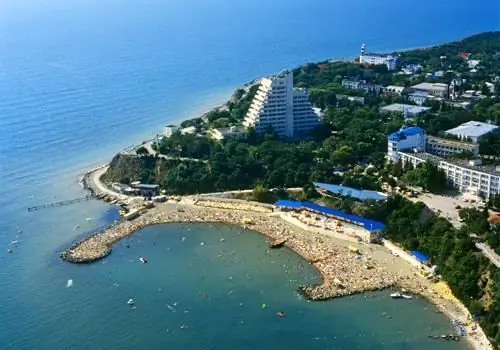- Author Harold Hamphrey [email protected].
- Public 2023-12-17 10:06.
- Last modified 2025-01-24 11:10.
In the central part of the Russian capital, parallel to the Moscow River, there is a Vodootvodny canal. On one of its banks is Sadovnicheskaya embankment. How does it look today and what sights are there on it? You will learn about this from our article.
Sadovnicheskaya embankment, Moscow: photo and description
The embankment runs along the left bank of the Vodootvodny Canal, which was dug at the end of the 18th century in one of the oxbow lakes of the Moskva River. The purpose of the construction of the canal was to protect the city from spring floods.
Sadovnicheskaya Embankment is located within the Central Administrative District of the capital. The nearest metro stations are Novokuznetskaya and Paveletskaya. The embankment stretches from the Chugunny Bridge in the west to the Maly Krasnokholmsky Bridge in the east, connecting Nizhnyaya Krasnokholmskaya Street with Balchug Street.

The total length of the embankment is about two kilometers. Buildings are numbered starting from the Cast Iron Bridge. The Commissariat Bridge conditionally divides the embankment into two parts - western and eastern.
Sadovnicheskaya embankment: history and moderndevelopment
The western part of the embankment is mostly non-residential. The eastern part is represented by military buildings, office buildings and fragmentary preserved historical buildings.
The toponym "Sadovnicheskaya Embankment" comes from the name of the former palace settlement Nizhniye Sadovniki, which was previously located in the area of Balchug Street. A spinning factory was built in the eastern part of the embankment in the first half of the 19th century. Later, a worsted combine was organized on its basis. Today, the site of this plant is a number of modern office buildings.
The presence of the military is a little holding back developers from the total development of the embankment. Nevertheless, very little remains of the historical quarters of the 18th-19th centuries. The most interesting buildings on Sadovnicheskaya embankment are the Church of St. George the Victorious and secondary school No. 518. We will tell more about these two buildings below.
Church of Great Martyr George the Victorious
In the quarter between Sadovnicheskaya embankment and the street of the same name, there is an old brick church built in the Russian style in the middle of the 17th century. The church has a picturesque silhouette and rich decor.

In 1760 St. George's Church was surrounded by a beautiful white stone fence with wrought iron bars. The fence, unfortunately, did not survive. In 1812, the church was badly damaged by a city fire, but by the 30s of the 19th century it was completely restored. In the middle of the last century, St. George's Church underwent a major restoration.
St. George's Church on Sadovnicheskaya Embankment is a traditional for Russian architecture quadrangle, covered with a two-tiered pyramid of kokoshniks. It is decorated with five domes - the central large one and four small ones at the corners. The decor of the temple is represented by a complex cornice, belts of panels and platbands with massive tops.
School 518
Building number 37 on Sadovnicheskaya embankment is occupied by secondary school number 518. This is the only state-protected building within this embankment.
The building of the 518th school is a vivid example of the so-called post-constructivism, which can be considered a kind of analogue of the Art Deco architectural style. This style originated in the late 1930s and marked the transition from constructivism proper to the Stalinist Empire style in Soviet architecture.

The school on Sadovnicheskaya embankment was built in 1935. The author of the project was the architect Ivan Zvezdin. The school was designed for 600 students. Features of two architectural styles can be traced in the central facade of the building: round porthole windows, typical of constructivism, and a light colonnade at the level of the second floor, which is more typical of neoclassicism. At the back corners of the school, terraces with balconies can be seen, designed for outdoor physical education classes.
Sadovnicheskaya embankment bridges
Sadovnicheskaya Embankment is connected to the opposite bank of the Vodootvodny Canal by five bridges. These are Cast Iron, Commissariatsky, Maly Krasnokholmsky,Sadovnichesky and Zverev bridges (the last two are pedestrian).
The oldest of this list is the Commissariat Bridge. It was built in 1927. But the most interesting and most beautiful of them can be called Sadovnichesky Bridge. It is easily recognizable due to its arched, arched shape.

Sadovnichesky bridge has its own secret. The fact is that it is based on two pipes that supply hot water to the entire Zamoskvorechye district. Actually, in order to hide them from sight and not spoil the appearance of this part of the capital, Sadovnichesky Bridge was built. By the way, the project was developed for him by a woman engineer Nina Bragina. The total length of the bridge is 32 meters. The height of the bridge allows small vessels to pass under its arch.
In conclusion…
In the central part of the capital, on the northern bank of the Vodootvodny Canal, there is Sadovnicheskaya Embankment (the Moscow district - Zamoskvorechye). The historical building of this embankment is partially lost. The only protected architectural monument here is building No. 37 (built in the 1930s), which now houses secondary school No. 518.






